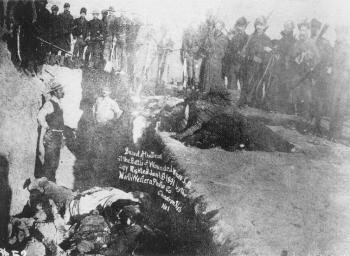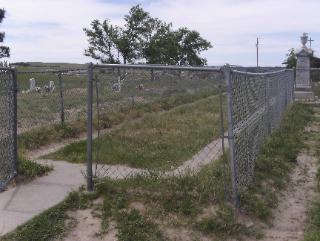| The Homestake Gold Mine By Steve Melendez |
The Homestake Gold Mine, in Lead, South Dakota, operated for 125 years and produced 41
million troy ounces of gold(over $24 billion at today's gold prices of over $600 per ounce). In
the summer of 1874, Lt. Col. George Armstrong Custer was sent into the Black Hills by Gen.
Philip Sheridan to search for gold. This was in direct violation of the Treaty of Fort Laramie of
1868. Today, there is a large photograph at the mine of Custer and his entourage entering
the Black Hills. The caption information tells us that after gold was discovered, many miners
came into the Black Hills in defiance of the army and the Indians but fails to mention that
Custer’s army was violating the 1868 Treaty. Neither does the caption information remind
visitors to the mine that article 6 of the U.S. Constitution calls a treaty the supreme law of the
land.
Custer came into the Black Hills with 1,000 soldiers, over 100 covered wagons, 2 or 3
gatling guns, a cannon, a 16 piece brass band mounted on white horses, and two
prospectors who were the experts on gold. On July 30th 1874 Custer sent a dispatch to Ft.
Laramie which read: “Gold has been found in paying quantities. I have upon my table 40 or
50 small particles of pure gold. In size averaging that of a small pinhead. And most of it found
today from one pan full of earth.” Today, the area where the placer gold (gold carried by
mountain streams) was found , is the town of Custer, South Dakota.
Probably the most significant bit of information absent from the Custer photograph at the
mine is what the President of the United States said to Congress the following year: “…The
Discovery of gold in the Black Hills, a portion of the Sioux Reservation, has had the effect to
induce a large immigration of miners to that point. Thus far the effort to protect the treaty
rights of the Indians to that section has been successful, but the next year will certainly
witness a large increase of such immigration. The negotiations for the relinquishment of the
gold fields having failed, it will be necessary for Congress to adopt some measures to relieve
the embarrassment growing out of the causes named. The Secretary of the Interior suggests
that the supplies now appropriated for the sustenance of that people, Being no longer
obligatory under the treaty of 1868, but simply a gratuity, may be issued or withheld at his
discretion.” President Ulysses S. Grant’s entire message can be found in Messages and
Papers of the Presidents Vol. 9 Pg.4306.
million troy ounces of gold(over $24 billion at today's gold prices of over $600 per ounce). In
the summer of 1874, Lt. Col. George Armstrong Custer was sent into the Black Hills by Gen.
Philip Sheridan to search for gold. This was in direct violation of the Treaty of Fort Laramie of
1868. Today, there is a large photograph at the mine of Custer and his entourage entering
the Black Hills. The caption information tells us that after gold was discovered, many miners
came into the Black Hills in defiance of the army and the Indians but fails to mention that
Custer’s army was violating the 1868 Treaty. Neither does the caption information remind
visitors to the mine that article 6 of the U.S. Constitution calls a treaty the supreme law of the
land.
Custer came into the Black Hills with 1,000 soldiers, over 100 covered wagons, 2 or 3
gatling guns, a cannon, a 16 piece brass band mounted on white horses, and two
prospectors who were the experts on gold. On July 30th 1874 Custer sent a dispatch to Ft.
Laramie which read: “Gold has been found in paying quantities. I have upon my table 40 or
50 small particles of pure gold. In size averaging that of a small pinhead. And most of it found
today from one pan full of earth.” Today, the area where the placer gold (gold carried by
mountain streams) was found , is the town of Custer, South Dakota.
Probably the most significant bit of information absent from the Custer photograph at the
mine is what the President of the United States said to Congress the following year: “…The
Discovery of gold in the Black Hills, a portion of the Sioux Reservation, has had the effect to
induce a large immigration of miners to that point. Thus far the effort to protect the treaty
rights of the Indians to that section has been successful, but the next year will certainly
witness a large increase of such immigration. The negotiations for the relinquishment of the
gold fields having failed, it will be necessary for Congress to adopt some measures to relieve
the embarrassment growing out of the causes named. The Secretary of the Interior suggests
that the supplies now appropriated for the sustenance of that people, Being no longer
obligatory under the treaty of 1868, but simply a gratuity, may be issued or withheld at his
discretion.” President Ulysses S. Grant’s entire message can be found in Messages and
Papers of the Presidents Vol. 9 Pg.4306.
AIGM President, Steve Melendez, and his children at the site of
the Homestake Gold Mine. The mine is an open pit 1250 ft.
deep and a half mile across. (Summer 2006)
the Homestake Gold Mine. The mine is an open pit 1250 ft.
deep and a half mile across. (Summer 2006)
The fact that President Grant would
suggest that a starvation policy should
be implemented may be difficult for
most Americans to believe but the
attitude of that day can be found in the
words of another President whose
image is carved 40 miles south of the
Homestake Mine on Mt. Rushmore.
suggest that a starvation policy should
be implemented may be difficult for
most Americans to believe but the
attitude of that day can be found in the
words of another President whose
image is carved 40 miles south of the
Homestake Mine on Mt. Rushmore.
"The Most ultimately righteous of all
wars is a war with savages. The rude,
fierce settler who drives the savage
from the land lays all civilized mankind
under a debt to him...it is of
incalculable importance that America,
Australia, and Siberia should pass out
of the hands of their red, black, and
yellow aboriginal owners, and become
the heritage of the dominant world
races."The Winning of the West Vol. 4
The Indian Wars Page 56 by President
Theodore (Teddy) Roosevelt
wars is a war with savages. The rude,
fierce settler who drives the savage
from the land lays all civilized mankind
under a debt to him...it is of
incalculable importance that America,
Australia, and Siberia should pass out
of the hands of their red, black, and
yellow aboriginal owners, and become
the heritage of the dominant world
races."The Winning of the West Vol. 4
The Indian Wars Page 56 by President
Theodore (Teddy) Roosevelt
Mount Rushmore in South Dakota
Wounded Knee

If you ever have the opportunity to visit the
mass grave site of the Wounded Knee
Massacre, you must reflect on why such a
thing happened. It was the 7th Cavalry that
did it, so the average American is led to
believe that it was revenge for Custer’s Last
Stand at the Little Big Horn. But knowing
President Grant’s words to Congress is to
know that the gold was on the Sioux
Reservation and that Custer was there in
violation of the Treaty of Ft. Laramie of
1868. And to know President Grant’s words
to Congress is to know that he called on
America to starve the Indians off their land.
mass grave site of the Wounded Knee
Massacre, you must reflect on why such a
thing happened. It was the 7th Cavalry that
did it, so the average American is led to
believe that it was revenge for Custer’s Last
Stand at the Little Big Horn. But knowing
President Grant’s words to Congress is to
know that the gold was on the Sioux
Reservation and that Custer was there in
violation of the Treaty of Ft. Laramie of
1868. And to know President Grant’s words
to Congress is to know that he called on
America to starve the Indians off their land.
Wounded Knee, December 1890.
Courtesy of the Denver Public Library
Courtesy of the Denver Public Library
When a president of a country openly calls for the
deliberate and systematic destruction of a people,
what other conclusion can be reached? If you ever
visit the mass grave site at Wounded Knee on the
Pine Ridge Reservation in South Dakota, know that
the men, women and children who were thrown into
this trench, were the victims of genocide.
deliberate and systematic destruction of a people,
what other conclusion can be reached? If you ever
visit the mass grave site at Wounded Knee on the
Pine Ridge Reservation in South Dakota, know that
the men, women and children who were thrown into
this trench, were the victims of genocide.
Wounded Knee Memorial Site, 2006.

